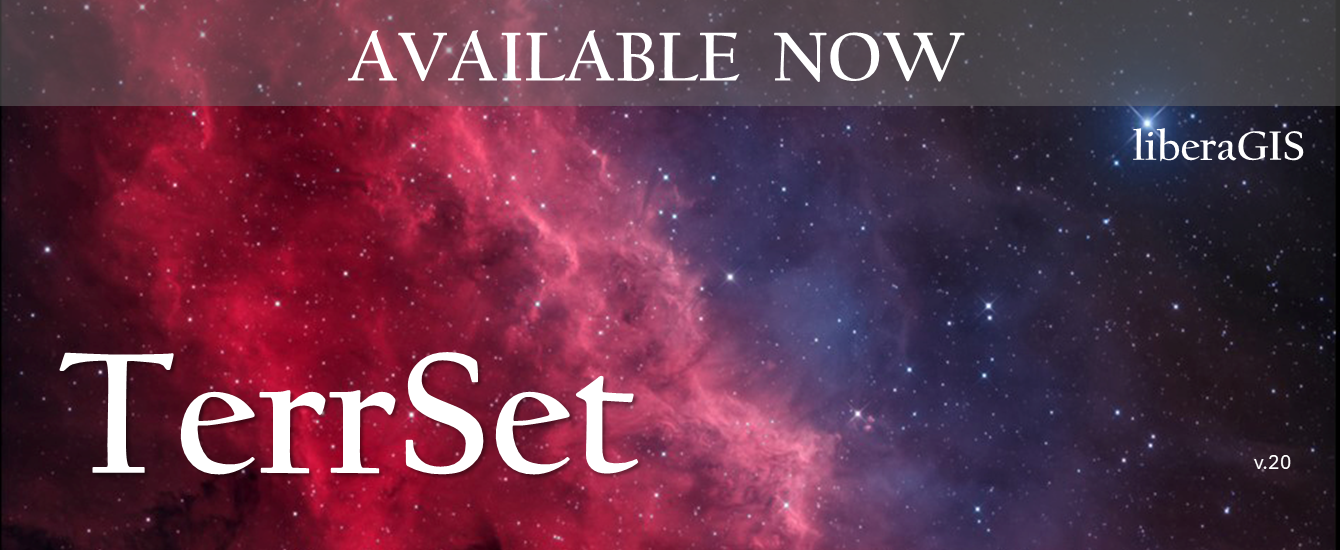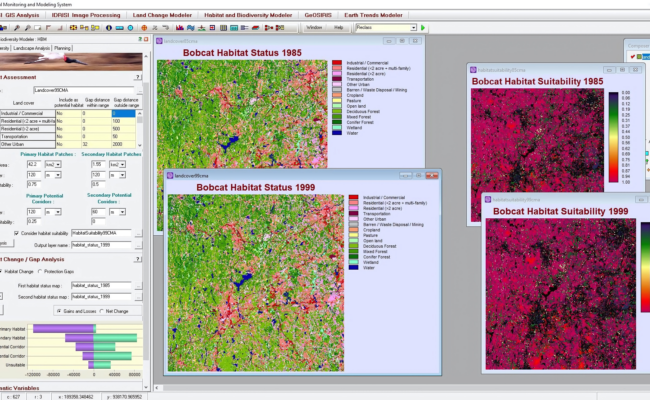
The Habitat and Biodiversity Modeler (HBM) includes a wide range of tools for habitat assessment and species distribution/biodiversity modeling. Locations are mapped into areas of primary and secondary habitat, primary and secondary corridor, and unsuitable lands based on land cover and habitat suitability. Parameters such as home range, size, buffer widths, and gap crossing distances are also used. In this example, land suitability for bobcats was assessed over fourteen years using land-use categories.
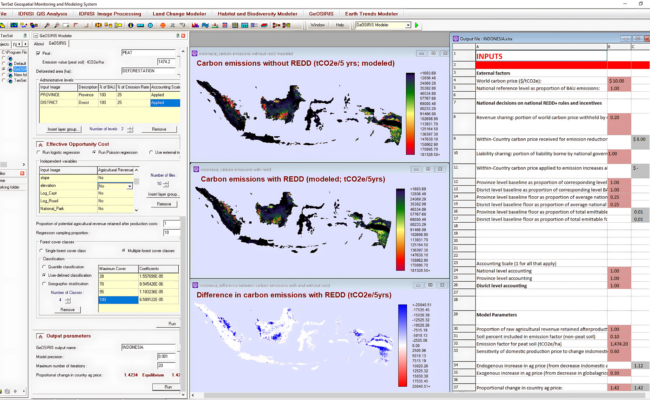
GeOSIRIS is a national-level planning tool for REDD (Reducing Emissions from Deforestation and forest Degradation). Developed in partnership with Conservation International, GeOSIRIS allows the user to specify the price of carbon, national level objectives for carbon emissions, the distribution of offset income between national and local levels, and a variety of economic parameters such as price elasticity of demand for agriculture on newly deforested land. GeOSIRIS empirically determines the effective opportunity cost based on a set of environmental variables and a provided map of potential agricultural revenue. Outputs include maps of expected carbon emissions with and without the proposed REDD policy as in the example for Indonesia above.
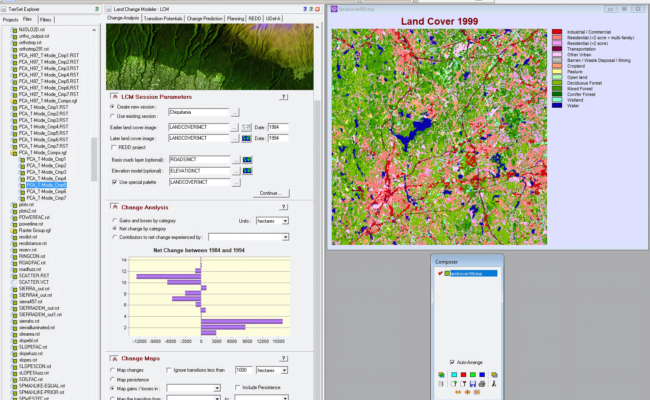
The Land Change Modeler (LCM) for analyzing land cover change, empirically modeling its relationship to explanatory variables and projecting future changes. From these, projections can be made of the expected land cover at a future date. The LCM dialogue in the image above shows the results of a Change Analysis for land cover in central Massachusetts. In this analysis we are able to see the loss/gain of each category in the legend.
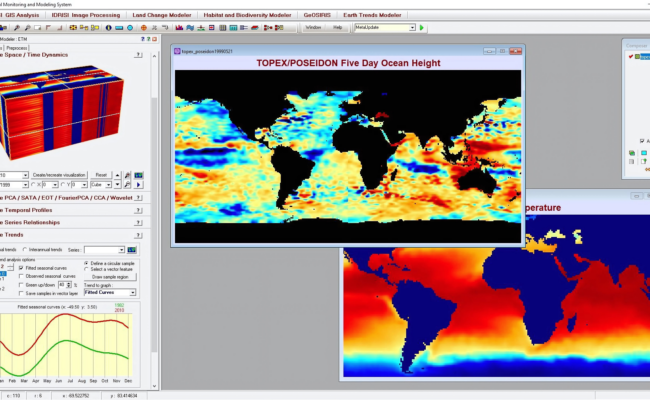
The Earth Trends Modeler (ETM) is an earth observation image time series tool designed to analyze trends documented in imagery. In this image, two displays of ocean change are documented. In the top left corner is ocean height over 5 days in May 1999. Note the drop in ocean height in the Pacific Ocean near central America (large dark blue blob) and the rise in height near Indonesia and Australia, this is because between 1997-1998 was the largest el Niño in history, which was followed by another historic la Niña in 1999. The second image in the bottom right is surface temperature during the same time as the top picture. Although not as stark, there is some temperature different in the same location where the drop in ocean height was in the image above.

The Habitat and Biodiversity Modeler (HBM) includes a wide range of tools for habitat assessment and species distribution/biodiversity modeling. Locations are mapped into areas of primary and secondary habitat, primary and secondary corridor, and unsuitable lands based on land cover and habitat suitability. Parameters such as home range, size, buffer widths, and gap crossing distances are also used. In this example, land suitability for bobcats was assessed over fourteen years using land-use categories.

GeOSIRIS is a national-level planning tool for REDD (Reducing Emissions from Deforestation and forest Degradation). Developed in partnership with Conservation International, GeOSIRIS allows the user to specify the price of carbon, national level objectives for carbon emissions, the distribution of offset income between national and local levels, and a variety of economic parameters such as price elasticity of demand for agriculture on newly deforested land. GeOSIRIS empirically determines the effective opportunity cost based on a set of environmental variables and a provided map of potential agricultural revenue. Outputs include maps of expected carbon emissions with and without the proposed REDD policy as in the example for Indonesia above.

The Land Change Modeler (LCM) for analyzing land cover change, empirically modeling its relationship to explanatory variables and projecting future changes. From these, projections can be made of the expected land cover at a future date. The LCM dialogue in the image above shows the results of a Change Analysis for land cover in central Massachusetts. In this analysis we are able to see the loss/gain of each category in the legend.

The Earth Trends Modeler (ETM) is an earth observation image time series tool designed to analyze trends documented in imagery. In this image, two displays of ocean change are documented. In the top left corner is ocean height over 5 days in May 1999. Note the drop in ocean height in the Pacific Ocean near central America (large dark blue blob) and the rise in height near Indonesia and Australia, this is because between 1997-1998 was the largest el Niño in history, which was followed by another historic la Niña in 1999. The second image in the bottom right is surface temperature during the same time as the top picture. Although not as stark, there is some temperature different in the same location where the drop in ocean height was in the image above.

The Habitat and Biodiversity Modeler (HBM) includes a wide range of tools for habitat assessment and species distribution/biodiversity modeling. Locations are mapped into areas of primary and secondary habitat, primary and secondary corridor, and unsuitable lands based on land cover and habitat suitability. Parameters such as home range, size, buffer widths, and gap crossing distances are also used. In this example, land suitability for bobcats was assessed over fourteen years using land-use categories.

GeOSIRIS is a national-level planning tool for REDD (Reducing Emissions from Deforestation and forest Degradation). Developed in partnership with Conservation International, GeOSIRIS allows the user to specify the price of carbon, national level objectives for carbon emissions, the distribution of offset income between national and local levels, and a variety of economic parameters such as price elasticity of demand for agriculture on newly deforested land. GeOSIRIS empirically determines the effective opportunity cost based on a set of environmental variables and a provided map of potential agricultural revenue. Outputs include maps of expected carbon emissions with and without the proposed REDD policy as in the example for Indonesia above.

